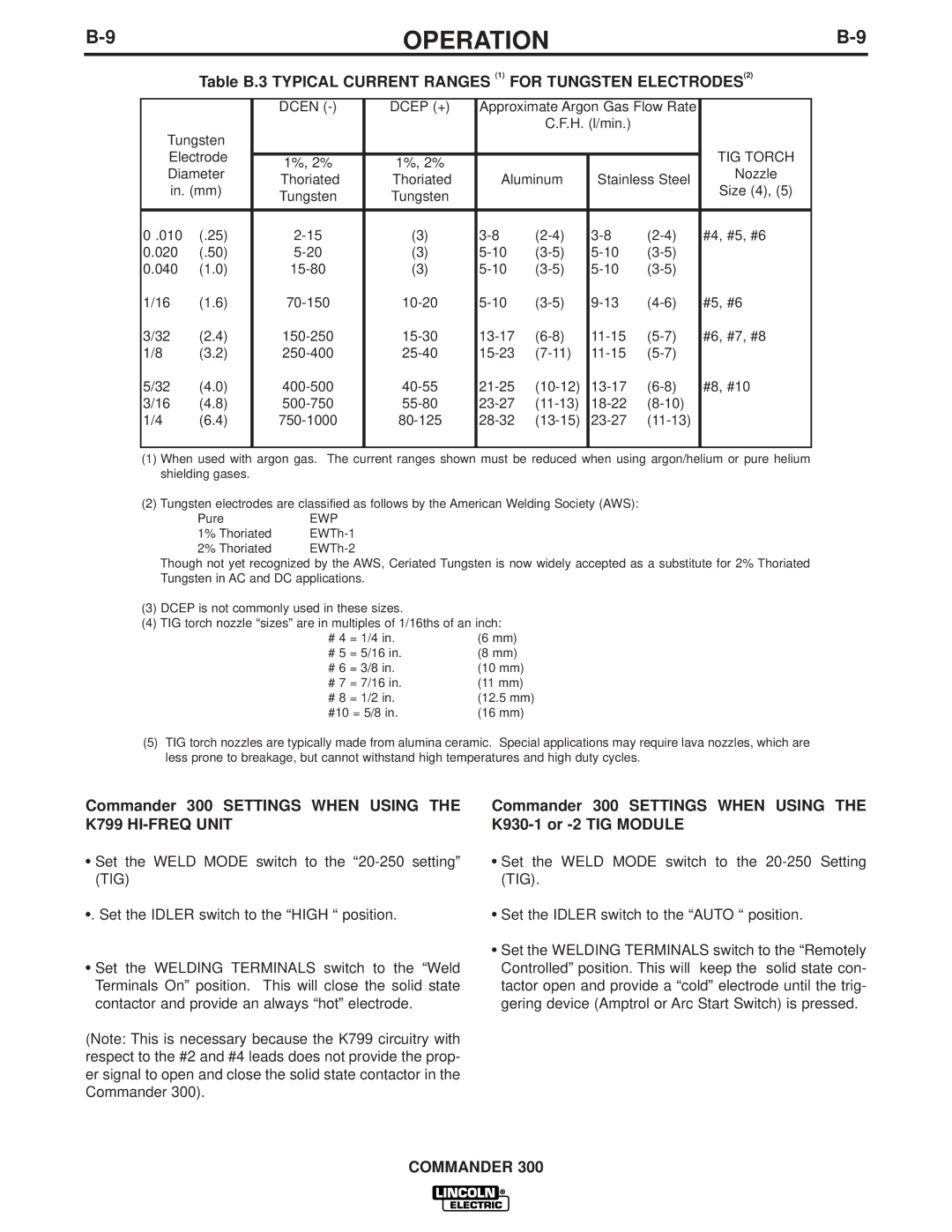|
|
|
| OPERATION |
|
|
| ||||
|
|
|
|
|
|
|
|
|
|
|
|
|
|
| Table B.3 TYPICAL CURRENT RANGES (1) FOR TUNGSTEN ELECTRODES(2) | ||||||||
|
|
|
|
|
|
|
|
|
| ||
|
|
|
| DCEN | DCEP (+) | Approximate Argon Gas Flow Rate |
|
| |||
|
|
|
|
|
|
| C.F.H. (l/min.) |
|
|
| |
|
| Tungsten |
|
|
|
|
|
|
|
| |
|
| Electrode |
|
|
|
|
|
| TIG TORCH |
| |
|
| 1%, 2% | 1%, 2% |
|
|
|
|
| |||
|
| Diameter |
|
|
|
| Nozzle |
| |||
|
| Thoriated | Thoriated | Aluminum | Stainless Steel |
| |||||
|
| in. (mm) | Size (4), (5) |
| |||||||
|
| Tungsten | Tungsten |
|
|
|
|
| |||
|
|
|
|
|
|
|
|
|
| ||
|
|
|
|
|
|
|
|
|
|
| |
|
| 0 .010 | (.25) | (3) | #4, #5, #6 |
| |||||
| 0.020 | (.50) | (3) |
|
| ||||||
| 0.040 | (1.0) | (3) |
|
| ||||||
| 1/16 | (1.6) | #5, #6 |
| |||||||
| 3/32 | (2.4) | #6, #7, #8 |
| |||||||
| 1/8 | (3.2) |
|
| |||||||
| 5/32 | (4.0) | #8, #10 |
| |||||||
| 3/16 | (4.8) |
|
| |||||||
| 1/4 | (6.4) |
|
|
|
|
| ||||
|
|
|
|
|
|
|
|
|
|
|
|
(1)When used with argon gas. The current ranges shown must be reduced when using argon/helium or pure helium shielding gases.
(2)Tungsten electrodes are classified as follows by the American Welding Society (AWS):
Pure | EWP |
1% Thoriated | |
2% Thoriated |
Though not yet recognized by the AWS, Ceriated Tungsten is now widely accepted as a substitute for 2% Thoriated Tungsten in AC and DC applications.
(3)DCEP is not commonly used in these sizes.
(4)TIG torch nozzle “sizes” are in multiples of 1/16ths of an inch:
# 4 = 1/4 in. | (6 mm) | |
# 5 | = 5/16 in. | (8 mm) |
# 6 | = 3/8 in. | (10 mm) |
# 7 | = 7/16 in. | (11 mm) |
# 8 | = 1/2 in. | (12.5 mm) |
#10 = 5/8 in. | (16 mm) | |
(5)TIG torch nozzles are typically made from alumina ceramic. Special applications may require lava nozzles, which are less prone to breakage, but cannot withstand high temperatures and high duty cycles.
Commander 300 SETTINGS WHEN USING THE K799 HI-FREQ UNIT
•Set the WELD MODE switch to the
•. Set the IDLER switch to the “HIGH “ position.
•Set the WELDING TERMINALS switch to the “Weld Terminals On” position. This will close the solid state contactor and provide an always “hot” electrode.
(Note: This is necessary because the K799 circuitry with respect to the #2 and #4 leads does not provide the prop- er signal to open and close the solid state contactor in the Commander 300).
Commander 300 SETTINGS WHEN USING THE
•Set the WELD MODE switch to the
•Set the IDLER switch to the “AUTO “ position.
•Set the WELDING TERMINALS switch to the “Remotely Controlled” position. This will keep the solid state con- tactor open and provide a “cold” electrode until the trig- gering device (Amptrol or Arc Start Switch) is pressed.
COMMANDER 300
